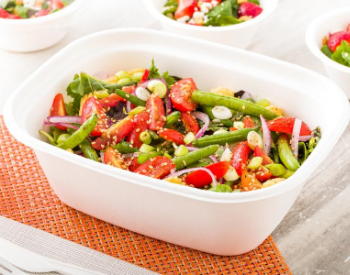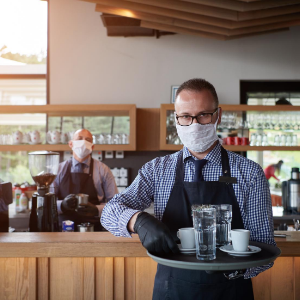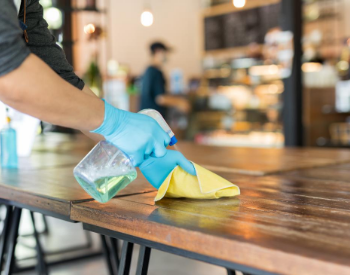In a recent survey conducted by Restaurantware, 57% of operators are looking for new packaging options. Business owners have realized the importance of finding the right packaging supplies to transport meals. Take out containers can influence your food presentation, support higher price points, keep food intact, and increase the perceived value of dishes.
While packaging has a big influence on whether or not a customer orders take out from your establishment again, so does the quality of food. This makes it essential to make adjustments to your menu in order to ensure your food tastes and looks as good as it looks. To ensure that your establishment meets the new expectations of customers, we’ve created this take out playbook that includes all the essentials you need to adapt to the changes in the industry and sell more take out orders.
Reimagining Service With Today’s Realities: Off-Premise
The foodservice industry has completely changed. More customers are ordering food for pickup or delivery rather than dining at restaurants because it provides them with peace of mind and convenience. However, patrons will not just order take out from any nearby location. They will do extensive research to find an establishment that prioritizes health and safety while offering the most bang for their buck.
If your restaurant relies on great service and ambiance to attract customers, it’s important to transition that into your off-premise dining experience. When guests order food for take out or delivery from your business, they expect to have that same one-of-a-kind experience as if they were dining at your establishment. To meet the new demands of customers, it’s important to consider making changes to your off-premise dining services.
Menu Adjustments To Meet Demand
All of the meal options on your menu may look and taste amazing. However, there are a number of foods that won’t hold their texture or taste the same if they aren’t enjoyed right away. For instance, by the time a sunny side up egg is delivered to a customer, it’s likely that the egg is overcooked or the yolk is all over the container. This makes it essential to adjust your menu for off-premise dining.
Ideally, a take out menu consists of foods that travel well. The goal is to avoid having foods on your menu that are extremely messy and easily get soggy. For instance, sandwiches and pizza are two of the most popular take out food options because they are easy to transport and enjoy. Adding items to your menu that are already popular in the take out market will allow you to easily attract customers and sell more take out orders. When packaging meals, it’s important to also consider including heating instructions for meals that need to be reheated or prepared at home.
Creating the optimal menu for off-premise dining consists of both trimming your menu and adding new menu options that are more suitable for take out. You can simply expand your menu by offering DIY cocktail or meal kits. These kits provide families the perfect opportunity to interact with one another and make delicious beverages or dishes. Rather than providing them a fun and enjoyable dining experience at your restaurant, you’re simply delivering it to their homes. All you need to do is package the ingredients and provide them with step-by-step instructions on how to prepare the dish or cocktail.
Better Packaging To Support Higher Price Points
Many businesses have increased prices of menu items, delivery charges, or added a COVID-19 fee to every check. Whether you own a fine-dining establishment or fast-casual restaurant, you need to support higher price points by making customers feel like they are getting their money’s worth.
“How to improve take out and delivery services?” is a question that many operators have because they want to increase sales in the fastest growing segments of the food industry. While you may offer similar meals as a number of restaurants in your town, the type of packaging you use will make your business stand out and attract customers.

The majority of establishments turn to foam clamshells to package meals. While foam containers are very affordable, they can easily break during transport and oily foods may seep through containers. By the time food orders arrive at your customers’ doors, meals will likely not be intact and look messy which doesn’t create a good look for your brand.
Instead, use packaging supplies that are constructed from high-quality materials. For example, containers made from kraft paper or sugarcane fibers elevate the aesthetics of meals because customers eat with their eyes. The right packaging will enhance your customers’ overall take out experience because it increases the perceived value of dishes.
Additionally, using carry out boxes that are grease-resistant to package oily foods or heat-resistant to deliver warm dishes helps retain the quality of meals. Packaging meals in the proper to go boxes ensures that food stays intact and looks enticing when delivered to customers. By choosing the right supplies for take out and delivery services, you can create a strong brand image and customers will be satisfied.
Presentation Influencing Guest Experience
Your restaurant may have had success attracting customers in the past because it has a great ambiance, beautifully plates each dish, and is located on a busy street. However, with fewer patrons dining at restaurants due to their concerns with health and safety, how can you attract customers to your off-premise operation? You can do this by putting a lot of thought and effort into the way they package meals.
The truth is that your customers make their first impression on your brand based on the packaging you use. However, once patrons open the box to see what’s inside, their impression of the food needs to match that same feeling they felt when they saw the way their order was packaged. Packaging food properly will instantly elevate the flavors and perceived value of dishes. To ensure every meal you package looks as good as it tastes, we’ve created a list that provides you with details on how to package meals for take out:
- Treat packaging like plating: Think about how you would plate a dish in your restaurant and package it the same exact way. Garnish and arrange the food how you typically would rather than tossing it in the container. This will allow you to create an everlasting impression on guests.
- Package sauces on the side: When a customer orders a dish at your restaurant, you typically serve it with the accompanying dressing on top. However, when packaging foods that feature condiments, package sauces in a separate container to prevent meals from getting soggy.
- Separate hot and cold foods: Transporting hot and cold food in the same container will affect the temperature of meals. This can compromise the quality of dishes and may pose a food safety concern. It’s important to package hot and cold foods separately.
Reimagining Service With Today’s Realities: Dine-In
COVID-19 has changed the way dine-in services operate. For example, customers now want establishments to be fully transparent about their health and safety protocols. Many cities also have occupancy regulations that restaurants must follow in order to operate. To keep up with today’s realities of dine-in services, it’s important for you to understand and adapt to the new normal.
Staff & Customer Safety
Numerous customers and foodservice workers don’t feel comfortable at restaurants. Health-conscious patrons are only ordering food for take out and delivery while workers who have been in the industry for decades are now looking for opportunities elsewhere. To make patrons and employees feel safe and protected, business owners should consider frequently sanitizing high-contact surfaces areas and making changes to their establishments.

Safety Measures For Customers
- Serve orders with disposable drinkware, flatware, and servingware
- Require customers to wear a mask unless they are eating or drinking
- Install sanitizing stations for customers to use before and after enjoying meals
- Require guests to wait for tables in their cars or create a designated waiting area
Safety Measures For Employees
- Eliminate in-person staff meetings
- Require employees to wear a face mask at all times
- Instruct employees that feel under the weather to stay home
- Rearrange kitchen work stations to help chefs practice social distancing
- Require staff members to wash their hands for at least 20 seconds before and after preparing food
Transparency In Communication & Protocols
To run a successful dine-in operation with today’s realities, it’s essential to have transparency with your customers about safety measurements your business is taking to keep everyone safe. Whenever you implement changes to your establishment, regardless of how big or small they are, be sure to update customers. Constantly informing patrons of new protocols and being an open book is what will allow your brand to build the trust and loyalty of patrons. You can simply do this by consistently posting on your social media channels and sending emails to customers.

Although it may not sound ideal, you should inform customers if a staff member has contracted the virus. This will allow patrons to know why you closed your doors which prevents them from drawing speculation about your business. You will also earn their trust because they appreciate transparency and understand that you’re taking proper precautions to ensure their safety.
While communicating with customers is essential, you also have to prove to them that employees are following new protocols in place. Staff members can demonstrate this by wearing gloves and masks when serving guests, preparing food, turning tables over, or sanitizing surfaces. You can also provide patrons with visibility of your open kitchen so they can see how chefs are preparing food and constantly washing their hands.
Navigating Changes In Dine-In Services
Dine-in establishments must follow local and state regulations in order to operate. While these guidelines are designed to keep customers and employees protected, it’s likely that they are impacting your business’ profits. We’ve created a detailed list to provide you with tips on how to navigate through the changes in the industry to make patrons feel comfortable and ensure your doors remain open.
How To Promote Social Distancing
- Separate the entrance of your business from the exit
- Limit the number of guests that can be seated together
- Create an area where customers can pickup take out orders
- Rearrange tables to ensure each party is at least 6 feet apart
- Place floor decals 6-feet apart throughout your establishment to direct traffic
How To Navigate Reduced Capacities
- Continue to offer take out and delivery services
- Communicate with landlords to find ways to reduce fixed costs
- Move indoor tables outside to create more space and an outdoor dining area
How To Make Outdoor Dining Comfortable
- Use citronella candles to help keep insects away
- Place fans near tables, POS systems, entrances, and exits
- Provide staff with water and offer customers water when they are seated
- Install table umbrellas to provide guests with shade and protect them from rain
We’re Here To Help!
During the COVID-19 outbreak, business owners were forced to either rely on take out and delivery services to stay afloat or shut down operations. Many establishments that remained open found success with off-premise dining. They were able to provide their employees with work and offer customers the meals they love while keeping everyone safe.
With stay-at-home orders being lifted, a number of locations have reopened their dine-in services. However, they realized that COVID-19 has completely reshaped the food industry. The majority of their sales are coming from off-premise dining and customers are choosing a location to dine at or order take out from based on the business’ safety protocols. Whether you’re looking to refine your packaging supplies or need support in reopening your business, our team of experts is ready and available to help you.








